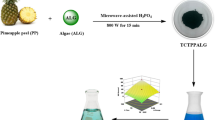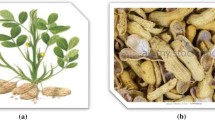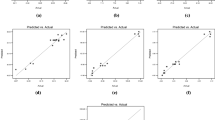Abstract
In this study removal of β-carotene from soybean oil by adsorption on acid activated smectite clay from Serbia was investigated and a factorial 23 experimental design was applied. The effects of relevant factors, such as temperature, solid-to-liquid ratio and time, on removal of β-carotene were investigated. In order to check these factors and their effect on the removal of β-carotene, we have established a model of this technique following a methodological strategy using experiments design. The mathematical model is established using a central composite design. The model describes the changes of the measured responses of β-carotene removal efficiency according to the temperature, solid-to-liquid ratio and time. The graphical representation of this model in the space of the variables enabled us to define the optimum conditions of these parameters. The optimum conditions to obtain the maximum removal of β-carotene from soybean oil were a temperature of 80°C, a solid-to-liquid ratio of 1: 25 and a time of 1255 s. Under these optimal conditions, the experimental values agreed with the predicted values, using analysis of variance, indicating a high goodness of fit of the model used and the success of response surface methodology for optimizing adsorption β-carotene of acid activated smectite clay from soybean oil.
Similar content being viewed by others
References
E. Srasa, F. Bergaya, H. van Damme, and N. K. Arguib, Appl. Clay Sci. 4, 411 (1989).
K. Boki, M. Kubo, N. Kawasaki, and H. Mori, J. Amer. Oil Chemists Soc. 69, 372 (1992).
G. E. Christidis, P. W. Scott, and A. C. Dunham, Appl. Clay Sci. 12, 329 (1997).
P. Falaras, I. Kovanis, F. Lezou, and G. Seiragakis, Clay Minerals 34, 221 (1999).
W. Zschau, Eur. J. Lipid Sci. Technol. 103, 505 (2001).
S. C. Kheok and E. E. Lim, J. Amer. Oil Chemists Soc. 59, 129 (1982).
G. E. Christidis and S. Kosiari, Clays Clay Minerals 51, 327 (2003).
Ž. Lazić, Design of Experiments in Chemical Engineering (Wiley-VCH, Weinheim, 2004).
E. Õayan and M. Bayramolu, Hydrometallurgy 57, 181 (2000).
E. Gulsah Kirali and O. Laçin, J. Food Eng. 75, 137 (2006).
T. Novaković, Lj. Rozić, S. Petrović, and A. Rosić, Chem. Eng. J. 137, 436 (2008).
Author information
Authors and Affiliations
Corresponding author
Additional information
The article is published in the original.
Rights and permissions
About this article
Cite this article
Rožić, L., Petrović, S. & Novaković, T. β-Carotene removal from soybean oil with smectite clay using central composite design. Russ. J. Phys. Chem. 83, 1621–1624 (2009). https://doi.org/10.1134/S0036024409090374
Published:
Issue Date:
DOI: https://doi.org/10.1134/S0036024409090374




